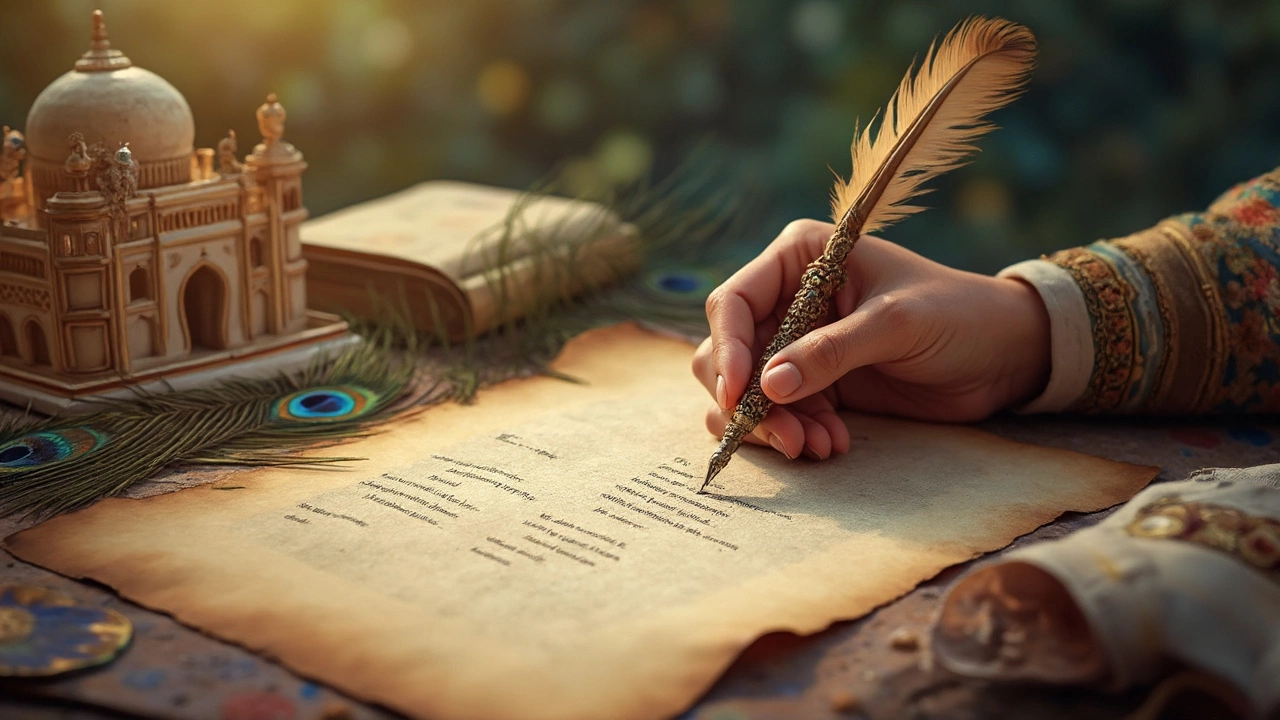Have you ever noticed how some poems take an unexpected turn at just the right moment? That's the magic of the Volta, a turning point that breathes new life into the verses. While the term 'Volta' might sound a bit exotic, it's actually quite a universal concept, one that resonates deeply in the world of poetry—especially in Indian short poetic forms.
Originally, Volta comes from Italian sonnets where it marks a shift in argument or theme around the ninth line. This twist often brings a surprising contrast that adds depth and complexity to the poem. But how does this relate to Indian poetry, you might ask? Well, Indian poets have masterfully adapted this technique to suit their own styles, weaving intricate stories within compact verses. Understanding how Volta works can enrich your appreciation of both traditional and contemporary poetry, making reading a far more engaging experience.
- The Essence of Volta in Poetry
- Volta's Journey to Indian Poetry
- Cultural Ties and Influences
- Tips for Writing a Volta Poem
- Appreciating Volta in Modern Verses
The Essence of Volta in Poetry
So, what exactly is a Volta? At its core, a Volta is that moment in a poem when something shifts—be it the tone, perspective, or emotion. Think of it like the plot twist you didn’t see coming in a movie, but in this case, it happens around a line or two in a poem. Traditionally found in Italian sonnets, the Volta tends to occur between the octave (the first eight lines) and the sestet (the final six lines), creating a kind of poetic tension before offering resolution.
This concept isn't just stuck in the past, confined to dusty tomes. Modern poets, including those crafting Indian poetry, have taken the heart of the Volta and made it their own. By doing so, poets can pack an emotional punch that hits readers right where it matters. This is why understanding the Volta is crucial—once you spot it, you can appreciate the craft behind your favorite poems even more.
Why is the Volta Important?
The Volta is the poet's tool to inject new ideas or emotions, often changing the direction of the narrative. Imagine reading a poem where everything's going great—flowers, sunshine, all that jazz—then bam! The next line transports you into a stormy night. That’s a Volta in action.
Recognizing Volta Across Cultures
Though it started in Italy, the Volta found a new home in various poetic traditions around the world. In poetry India, for instance, similar twists can be found in works like ghazals and other short forms. Indien poets enjoy playing with dual themes—like love and loss or joy and sorrow—using Voltas to contrast these in just a few lines.
| Form | Traditional Volta Placement |
|---|---|
| Italian Sonnet | Line 9 |
| Shakespearean Sonnet | Line 13 |
Recognizing a Volta doesn’t just make you a better reader but can inspire your own writing, too. And let's be honest, who doesn’t want to add a bit of dramatic flair to their verses? Whether you're a reader or a poet, catching that pivot point can make all the difference.
Volta's Journey to Indian Poetry
If you're wondering how Volta poems made their way into Indian literary traditions, you're not alone. Volta's journey started in Italy with the rise of the sonnet in the 13th century, but its appeal spread far and wide, eventually reaching Indian shores. As with many art forms, Indian poets have taken global influences and woven them into their own tapestry of storytelling.
The real push came during the British Raj when English literature became a significant part of educational curricula. Indian poets, both in English and regional languages, began to experiment with these structures. They took the idea of a 'turn' in poetry and used it to express complex emotions and cultural narratives. This introduced a new layer to traditional forms, such as ghazals and even haikus, with a distinctive Indian flair.
Interestingly, some scholars argue that the concept of Volta wasn't entirely foreign to India. Forms like the 'Chaupai' in regional poetry already contained thematic shifts akin to the Volta. However, the term 'Volta' gave a new lens through which Indian poets could explore and innovate.
Notable Examples
One can't ignore the influence of poets like A.K. Ramanujan who integrated these styles seamlessly. His works often capture the sudden twists in human emotion, perfectly embodying the Volta style. Additionally, contemporary poets are also embracing this structure, bringing fresh perspectives to age-old themes.
Why It Stuck Around
The reason Volta has found a permanent home in Indian poetry? It's versatile. Whether commenting on social issues or exploring personal identity, the ability to introduce an unexpected shift creates layers that resonate well with diverse audiences.
In today's globalized world, poetry styles influence each other, crossing cultural boundaries. It's this cross-pollination that keeps poetry alive and evolving, making Volta an exciting aspect for both poets and readers.

Cultural Ties and Influences
India's rich poetic heritage naturally adapts and transforms various elements of global poetry, including the Volta poem. While its roots may lie in Italian sonnets, the Volta has found a new home in the intricate world of Indian poetry. Indian poets have a knack for blending traditional forms with contemporary themes, and the Volta is no exception.
Take, for instance, India's ghazal form. While it's structurally different from the Western sonnets, the ghazal also embraces a turning point, often delivering an emotional punch in its final couplets. The idea of transformation or sudden insight resonates with the idea behind a Volta, weaving a common thread between distinct cultures.
From Global to Local
The beauty of poetry is in its adaptability, and Indian poets often incorporate global techniques while still maintaining a local flavor. This fusion can be seen in how modern Indian poets borrow the concept of the Volta to enhance storytelling in their works. By creating contrasts in language, tone, or setting, they breathe life into age-old traditions, making them relevant for today's audiences.
Indeed, the incorporation of Volta has subtly influenced various regional poetry forms across India. For example, in Marathi abhang poetry, we see a thematic twist where poems often reflect a sense of personal or social reform. The turning point, much like the Volta, adds depth and surprise, keeping the reader engaged till the end.
Influence on Modern Indian Poetry
As the world becomes more connected, cross-cultural exchanges continue to shape the literary landscape. The poetry India scene actively includes these elements, creating a vibrant tapestry of ideas. New-age poets draw inspiration from diverse sources, skillfully using the Volta as a tool for narrative and emotional impact.
What's more, some poets make conscious choices to use the Volta to address modern themes such as identity, climate change, and social justice, giving their work a punch that's both relatable and thought-provoking. This dynamic interplay of tradition and modernity ensures that the art of poetry remains alive and evolving.
Tips for Writing a Volta Poem
Crafting a Volta poem might sound challenging, but it's really about mastering the art of surprise in poetry. The Volta is all about that unexpected twist or turn, so having this in mind can guide your writing process.
Understand the Structure
Before you start, get a grip on the typical structure of poems that use a Volta, like sonnets. These usually follow a clear format: an opening argument or theme, followed by a contrasting shift—the Volta. Stick to a known form initially; once comfortable, you can experiment.
Infuse a Twist
The key to a great Volta is a dramatic shift in tone or perspective. To achieve this, outline your poem’s initial theme, then brainstorm ways to turn it on its head. It helps to think in contrasts: light vs. dark, joy vs. sorrow, certainty vs. doubt. This change should feel natural, like a new lens suddenly focusing the picture differently.
- Identify Your Theme: Choose a clear theme for your poem. This sets up the premise that your Volta will later challenge or reevaluate.
- Plan the Twist: Decide where the turn will happen. While traditional sonnets place it around the ninth line, your placement can vary.
- Use Strong Imagery: Which words or images will effectively convey the new perspective? Strong visuals can powerfully mark the shift.
Practice with Classic Forms
Start by practicing within known structures, like the Italian or Petrarchan sonnet. These forms provide a reliable scaffold to lean on, helping isolate the Volta without getting bogged down in structural details.
Once you're comfortable, experiment by blending the Volta into shorter Indian forms, such as the Haiku or Ghazal. Since these emphasize brevity, they'll push you to hone your ability to create impactful turns in fewer words.
Revise and Seek Feedback
Revision is key to polishing your Volta. Pay close attention to clarity—does the twist make sense? Reading aloud can highlight awkward transitions. Also, get feedback; fresh eyes might catch what you missed.
Remember, every poem is a playground for your thoughts. Experiment with various approaches to see what resonates with you. Over time, your command of the Volta will not only improve but also deepen your overall poetic expression.

Appreciating Volta in Modern Verses
In today's fast-paced world, poetry continues to evolve, yet the Volta poem retains its charm, even influencing modern Indian poets. This shows how adaptable and timeless this poetic device is, offering a fresh perspective with each twist and turn.
Many contemporary poets embrace the Volta for its ability to create sharp contrasts in tone and theme, often mirroring the complexities of modern life. By using Volta, poets can address current issues while still providing that unexpected shift that keeps us on our toes. It's not just about a change in the poem's content; it's about encouraging readers to think differently or see a situation in a new light.
Spotting Volta in Modern Poetry
When reading modern verses, identifying a Volta can be incredibly rewarding. So, how do you spot it? Look for a sudden change in direction, whether it’s emotional, thematic, or tonal. This is often marked by words like 'but', 'yet', or 'still', signaling a shift that redefines what's been said.
- Emotional Shift: A poem might start with a melancholy tone only to suddenly inject a sense of hope or resolve.
- Thematic Shift: A verse discussing nature could turn into a reflection on human frailty.
- Tonal Shift: A light-hearted poem might bring an unexpected serious note, challenging the reader’s initial engagement.
Embracing Volta while exploring Indian poetry can deepen your reading experience. Modern poets like Vikram Seth and P. Lal have utilized this tool, blending it seamlessly into their work, showcasing its versatility across cultures and languages.
The Role of Workshops and Poetry Circles
In India, poetry circles and workshops often focus on the Volta as a crucial element, encouraging budding poets to incorporate this technique creatively. These gatherings emphasize its role not just in form, but as a means for greater emotional and intellectual engagement.
As a result, both listeners and readers can appreciate this shift, adding layers of meaning to the experience. Engaging with Volta can transform a simple poem into a dialogue between traditions and contemporary life, bridging gaps and fostering deeper understanding.
